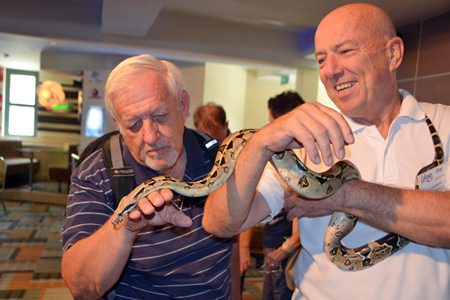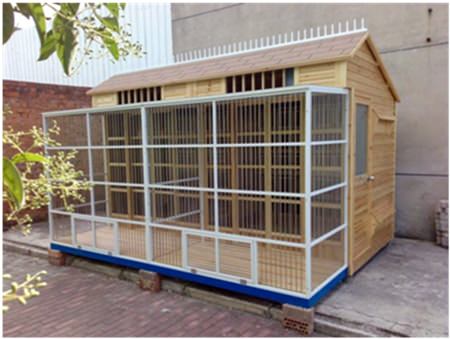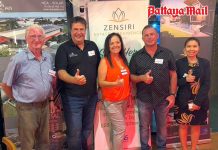PCEC hears about some unusual hobbies from Bruce Kehlet at their Sunday, April 12 meeting. Bruce likes to breed and race pigeons as well as keeping non-poisonous snakes as pets. Both hobbies are a world apart from stamp collecting. Bruce’s background is primarily in computer systems as an analyst/programmer. He retired to Pattaya because of a lung disorder and has benefited greatly from the climate. Bruce has been called upon a few times to relocate a Russell’s Viper (a lethal tree snake) and a baby cobra from houses and condos in the Pattaya area.
Bruce started his presentation by talking about his interest in racing pigeons. It began about the same time as he developed an interest in snakes. A neighbour where he grew up in Australia kept racing pigeons and he often peered through the fence and was later introduced by the neighbour to the world of racing pigeons. His parents didn’t like the idea of having pigeons around, so he kept his at a friend’s house.
 Bruce Kehlet introduces his “pet” Anna to his PCEC audience and explains the benefits of having snakes as pets.
Bruce Kehlet introduces his “pet” Anna to his PCEC audience and explains the benefits of having snakes as pets.
Pigeons can fly up to 1,000 kilometres to return home, Bruce said. Not all pigeons make it home. There are many possible obstacles, including falcons and hawks that are looking for a tasty meal. Bruce explained that racing pigeons were used as far back as the 18th century to carry messages. News of the outcome of the battle of Waterloo reached London by carrier pigeon.
Historically, Belgium, Holland, and Italy have been the hot spots for pigeon racing. More recently, the hobby has caught on in a big way in China, which now has more racing pigeons than the rest of the world combined. He mentioned that in the Pattaya region, there are about 20-25 Thais who raise pigeons and there are about 12-13 farangs who buy racing pigeons. Further, the number of racing pigeons in the area ranges from 30-40 to several hundred at any given time.
 After draping Anna around his neck, where she stayed quite content, Bruce Kehlet shows off his other pets to the PCEC, this one a corn snake.
After draping Anna around his neck, where she stayed quite content, Bruce Kehlet shows off his other pets to the PCEC, this one a corn snake.
Many people denigrate pigeons as “rats with wings.” But, Bruce explained, the pigeons that you see on the street are not in good health; racing pigeons are in much better shape. A male racing pigeon weighs about a pound; the females, about 13 ounces. Racing pigeons are housed in pens, called “lofts”. Bruce said he has 15 pigeons in his loft.
There is a big pigeon race every December in Bangkok. Bruce said that the bird that won the race last December was then sold for 3.6 million baht. There are also smaller races every Sunday in Bangkok. Because pigeons always fly home, they are transported to a place that is far away from home for the races. In a race, the pigeons will be flying to various locations (i.e., wherever their home is), which means that the distance each pigeon flies will vary. The winner is the pigeon with the fastest velocity or rate of travel – in other words, the pigeon that takes the least time per kilometre flown.
 PCEC members Roger Fox and Roy Albiston get acquainted with Anna. From Roy’s expression, maybe he will take up Bruce’s hobby; but Roger looks as though he is not yet convinced.
PCEC members Roger Fox and Roy Albiston get acquainted with Anna. From Roy’s expression, maybe he will take up Bruce’s hobby; but Roger looks as though he is not yet convinced.
The pigeons usually do not stop on their trip home. However, if they are travelling over a very long distance and if the weather is very hot, they sometimes stop for a quick drink of water, Bruce explained. Over the years, different methods have been used to measure how fast the pigeon is travelling. These days, the birds are usually tagged with a device that sends a radio signal.
If you buy a racing pigeon, Bruce explained, you do it for breeding. It would not make sense to race a pigeon after you buy it because you will be taking the pigeon to a new home and it will be inclined to fly back to its original home when released into the air.
For the second part of his presentation, Bruce showed off Anna, his pet Columbian red-tailed boa constrictor. Anna sat comfortably on Bruce’s shoulders and wrapped herself around his neck during this part of Bruce’s presentation.
Bruce said that the boa constrictors make wonderful pets. They don’t bark, they are quiet and affectionate, and they can sit on your shoulders for hours. He bought Anna in 2012 for 2,500 baht. Bruce said that like all snakes, Anna is cold-blooded. If left in direct sunlight, Anna would die. But he also said that if left in a very cold room, Anna would die from hyperthermia because she would not be able to regulate her body temperature. Bruce said that Anna would have a couple of rats for dinner that night. Bruce said that he started to keep snakes as pets in 1964, when he was a young lad. He became interested because there was a snake club at his school. His parents, as with the pigeons, did not approve of his hobby, so he also kept his snakes at a friends home whose parents were not so picky.
 Bruce showed this picture as an example of a pigeon loft. He mentioned that the biggest lofts can hold up to 5,000 pigeons.
Bruce showed this picture as an example of a pigeon loft. He mentioned that the biggest lofts can hold up to 5,000 pigeons.
As a caution, Bruce said that when you come across a snake, always assume that it is poisonous. The best thing to do is to stand completely still and evaluate the situation. You can talk – as in shout for help – because the snake cannot hear. If you can, Bruce said you should back away from the snake. Further, do not try too kill it. For one thing, you would be putting yourself at risk. For another, the snake hasn’t done anything bad. Snakes are good for the environment because they eat rats and other vermin.
Bruce also showed off two smaller snakes – an American coloured corn snake, which has a reddish hue and another of the same breed but with a different gene such that it maintains a more natural brown colour. At the end of his presentation, he invited members of the audience to join him outside to hold and get better acquainted with his pets.
After the presentation, MC Richard Silverberg brought everyone up to date on upcoming events and called on Roy Albiston to conduct the Open Forum, where questions are asked and answered about Expat living in Thailand, especially Pattaya.
For more information on the PCEC’s many activities, visit their website at www.pcecclub.org.




